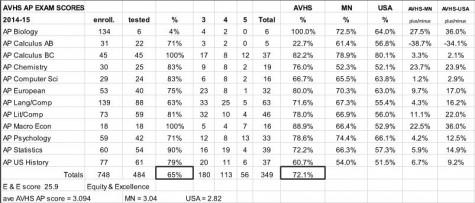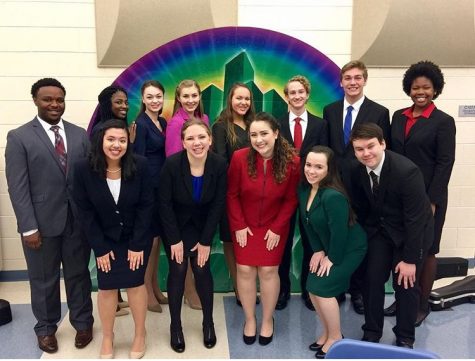AP Stats (Not the Class)
Desks arranged in rows for testing
That time of the year is approaching again!
No, not prom, (though check out Sophia’s article if you need advice for that)–the nerve wracking, stress inducing, hand numbing experience, also known as AP testing season.
Tuesday, March 8, marked the closing of the sign-up window for students who’ve chosen to take an AP exam. For some seniors who may have refrained from taking AP classes, the closure meant the last possible chance to earn college credit; but for our juniors, sophomores, and freshmen, they still have the chance to open up many opportunities through the AP program.
As some students may already know, AP stands for “Advanced Placement” and is a program run by The College Board – the same organization responsible for the development of the SAT. AP grants students the opportunity to earn college credits by offering college-level curriculum and exams in a high school setting. Many universities and colleges award placement or course credits to students who pass the AP exam with a high enough score.
According to the Annual AP Program Participation and Performance Data, the program has been increasing in popularity ever since its inception in 1955. As indicated by the 2015 data, a total of 21,594 schools participated in the program, with nearly 2.5 million students taking almost 4.5 million exams and over 4,000 colleges granting course credit nationwide.
Some of those 2.5 million students are right here within our walls. School-wide, AP exam passing rates for students have fared well above average, with our passing rate above the 70th percentile, (The nationwide average is 56.2%, according to the 2015 AP Score Distribution report.) 744 students districtwide were also recognized as AP Scholars last year, according to the 2015 District 196 Year in Review.

AP exam statistics for AVHS. Courtesy of Pete Buesgens
Out of the thirty AP courses offered by the The College Board, AVHS offers students the opportunity to enroll in twelve of them, ranging from U.S History to Computer Science. Students also have the option to take the AP Biology and AP Physics test if enrolled in either Honors Biology and Honor Physics (and if they’re willing to do some preparation for the AP exam outside of school).
According to the most recent AP student enrollment numbers for AVHS, 748 students took an AP class during the 2014-15 school year; out of those, 484 took an AP exam. One such student is AVHS senior Heidi Le.
“With AP courses you do a lot of learning on your own because of all the material that needs to be covered,” says Le. “Finding the best way for your own personal learning has been the most challenging part.”
“[AP classes] require more time than regular or honors courses,” says AVHS senior Ty Dwyer, “but are well worth it. They provide a good pathway into college and I also think they make school more interesting.”
Although AP classes have a reputation for being noticeably harder than your average mainstream or honors course, the benefits – both educationally and financially – tend to outweigh the textbooks and homework.
“AP Lit has been the most difficult because reading and writing have never been my strongest subjects,” says Le. “But by taking the class I am becoming a better writer and I do not regret it!”
The benefits are also evident from a teacher’s perspective.
“In the AP English classes specifically,” says AP Lit teacher Rose Jagim, “[it] pushes students to be critical readers, writers, and thinkers in a way that might reach beyond our other classes.”
“ Another value of taking an AP class is to be in a learning environment with other students who exhibit those same qualities,” says science teacher Erin Adams. “AP students are self-motivated, independent learners who exhibit excellence in the classroom and beyond.”
From a financial perspective, the benefits are quite significant. Students are able to potentially save on their college tuition by paying around $70 to take an AP exam, as opposed to paying thousands of dollars to earn an equivalent credit in college. However, it must be noted that not all colleges accept AP credit, such as Dartmouth or Harvard.
“It is up to the student to do their own homework on the school they plan to attend,” says Jagim, “but at the U of M, getting a 3, 4, or a 5 on the AP Lit exam can substitute for both the freshman writing requirement and the literature core requirement–7 credits total. With the current tuition at the U that equals about $3200.”
Still, some students may be wary about taking an AP class or exam and may wonder if they truly have what it takes to be successful. To ease any nerves, AVHS students and teachers offer their advice.
“AP classes are a good choice for everyone, as long as they are willing to make the commitment and work hard,” says senior Davita Blyakher.
A strong dedication to academics is seemingly unanimously agreed as a “must” in order to achieve success in an AP class. More importantly, take risks.
“You have to know that the expectations are a lot higher for students in an AP class,” says Jagim. “It is going to mean you will have to work hard, but if you are willing to go for it, than you should do it.”
“The most important quality a student needs to be successful in an AP class is a passion for the content,” says Adams. “Successful students are independent learners, are willing to work hard, and are not afraid of failure.”
As for this reporter’s opinion, although the workload can get stressful at times, the amount of experience and satisfaction gained once you challenge yourself and expand your horizons more than makes up for a couple of late nights spent working on a reading or an essay.
Most importantly, as said by Mrs. Jagim: “Remember that in some cases, an experience is worth more than a particular grade.”








Adam Stacer • Mar 15, 2016 at 1:56 pm
You said that The College Board is responsible for creating the ACT, but they actually create the SAT, not the ACT. The ACT is their own company that creates their own test.
Ivan Calixto • Mar 16, 2016 at 11:59 am
Oops, thanks for pointing out that little bit of misinformation there. The correction has been made.